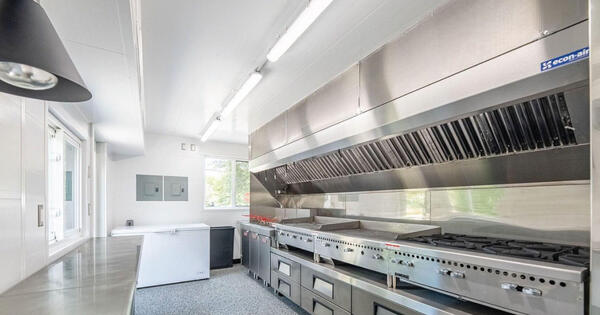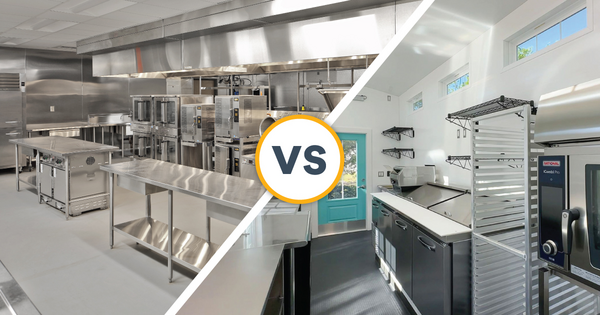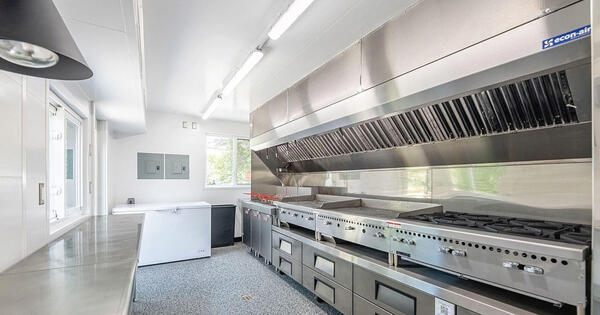Choosing the right commercial kitchen wall panels is essential for meeting health, safety, and hygiene standards in food service environments. This guide compares PVC, FRP, and stainless steel panels, outlines key performance and compliance considerations, and explains why Trusscore Wall&CeilingBoard is the superior solution—offering unmatched durability, easy cleaning, quick installation, and full regulatory compliance for modern commercial kitchens.
In a commercial kitchen, walls endure constant exposure to heat, steam, grease, and rigorous cleaning. Choosing the right commercial kitchen wall panels is critical not only for durability but also for hygiene, safety, and regulatory compliance. The right wall system can withstand heavy use, prevent bacterial growth, and make maintenance straightforward, supporting both operational efficiency and a professional kitchen appearance.
Walls in a busy kitchen face numerous challenges: moisture from steam, splashes from food prep, impact from carts or utensils, and frequent cleaning with chemicals. Modern wall panels are designed to meet these demands, offering seamless, non-porous surfaces that protect walls while helping kitchens comply with strict health and safety standards.
What Are Commercial Kitchen Wall Panels?
Commercial kitchen wall panels are purpose-built wall coverings designed for professional food prep environments. Unlike residential panels or standard drywall, these panels resist moisture, impact, and contamination. Their role extends beyond aesthetics—they’re critical in maintaining food safety, supporting cleaning protocols, and ensuring compliance with local, national, and international regulations.
A commercial-grade wall panel is typically non-porous, water-resistant, and durable. It prevents mold and bacteria from forming and stands up to heat, steam, and frequent cleaning. Regulatory standards such as Canadian Food Inspection Agency (CFIA), Food and Drug Administration (FDA), U.S. Department of Agriculture (USDA), and International Building Code (IBC) provide benchmarks that ensure panels are safe and suitable for food preparation areas. Panels meeting these certifications make it easier for kitchens to pass inspections while maintaining high sanitation standards.


What Key Requirements Should Commercial Kitchen Wall Panels Meet?
When selecting commercial kitchen wall panels, it’s important to consider how they’ll perform under the pressure of daily operations. Walls in food prep areas must resist moisture, impacts, and frequent scrubbing to remain safe and functional over time. The best panels combine long-lasting durability with hygienic design to simplify cleaning and reduce maintenance.
High humidity, steam, and chemical exposure make kitchens tough environments for wall materials. Moisture-resistant panels prevent the growth of mold and mildew, while non-porous surfaces keep bacteria from settling into cracks or seams. Impact resistance also matters—carts, utensils, and busy staff can easily damage weaker materials, leading to costly repairs or code violations.
When evaluating your options, look for panels that check all the boxes for performance, sanitation, and aesthetics:
- Durability and impact resistance: Withstands dents and scratches from carts, tools, and daily wear.
- Hygienic, non-porous surface: Prevents mold, mildew, and bacterial growth.
- Chemical and moisture resistance: Holds up against steam, water, and strong cleaning agents.
- Ease of installation and maintenance: Installs quickly and allows for simple wipe-down cleaning.
- Aesthetic appeal: Offers a clean, professional look suitable for open or customer-facing kitchens.
Panels that meet these standards create safer, more efficient workspaces while lowering overall maintenance costs—a win for both designers and operators.
What Materials Are Commonly Used for Commercial Kitchen Walls?
Not all commercial kitchen wall coverings are created equal. Each material comes with its own advantages and drawbacks in terms of durability, cleanliness, and cost. Understanding these differences helps you specify the right wall system for your project.
Here’s how common wall materials stack up in commercial kitchens:
- Fiberglass Reinforced Panels (FRP): FRP wall panels for commercial kitchens are a popular, budget-friendly option, but they can develop issues over time. Seams and adhesive joints are prone to moisture buildup, which can lead to delamination and mold growth behind panels.
- Stainless Steel Panels: Commercial kitchen stainless steel wall panels are extremely durable and heat-resistant, making them ideal near cooking surfaces. However, they’re costly, challenging to install, and can show fingerprints and smudges easily.
- PVC Panels: Trusscore Wall&CeilingBoard delivers superior performance in demanding environments. These restaurant kitchen wall panels are lightweight, waterproof, and easy to clean, with a smooth, seamless finish that prevents dirt and bacteria buildup. Unlike FRP, they won’t delaminate or harbor moisture, making them a long-term, hygienic solution for busy kitchens.
Choosing the right material ensures your kitchen walls stay compliant, attractive, and low-maintenance for years to come—saving you both time and money in the long run.
Why Choose Trusscore Wall&CeilingBoard for Commercial Kitchens?
When it comes to high-performance commercial kitchen wall panels, Trusscore Wall&CeilingBoard stands out as a durable, hygienic, and easy-to-install solution designed specifically for demanding food service environments. It addresses the key challenges kitchens face — moisture, impact, and sanitation — while delivering a clean, professional look that lasts.
Unlike traditional materials that can absorb moisture or trap bacteria, Trusscore Wall&CeilingBoard is made from 100% PVC, making it completely water-resistant and non-porous. The smooth surface wipes clean in seconds, preventing mold, mildew, and bacterial growth even in areas that see constant humidity and daily washdowns.
Key advantages include:
- Exceptional hygiene: Non-porous, water-resistant panels prevent mold, mildew, and bacteria from taking hold.
- Quick, easy cleaning: Smooth, stain-resistant surface wipes clean in seconds with soap, disinfectant, or sanitizer.
- Seamless finish: Tongue-and-groove interlocking system creates a watertight surface that keeps dirt and moisture out of joints.
- Fast installation: Lightweight panels can be installed twice as fast as FRP or tile, often by a single person.
- Long-term durability: Impact-resistant construction stands up to everyday wear and tear, maintaining a professional look over time.
In short, Trusscore Wall&CeilingBoard delivers everything commercial kitchens need in a wall system — durability, cleanliness, and efficiency.



What Design and Compliance Considerations Should Architects and Builders Think About?
For architects, designers, and specifiers, selecting the right commercial kitchen wall covering isn’t just about performance — it’s also about meeting regulatory standards and achieving the desired aesthetic. Trusscore Wall&CeilingBoard makes it easy to satisfy both.
Regulatory and performance benefits include:
- Food-safe compliance: Meets or exceeds FDA and CFIA requirements for use in food preparation and storage areas.
- Fire safety: Achieves a Class A fire rating, the highest possible classification for flame and smoke performance.
- Moisture resistance: Performs reliably in high-humidity and washdown environments, preventing material degradation.
Design and sustainability advantages:
- Clean, neutral appearance: Available in sleek, bright finishes that enhance visibility and complement both back-of-house and open-kitchen spaces.
- Integrated design flexibility: Compatible with matching trims, corners, and accessories for seamless transitions between walls, ceilings, and built-in features like lighting or ventilation.
- Sustainable choice: Fully recyclable material that helps reduce waste during installation, renovation, or replacement — aligning with modern sustainability goals.
With Trusscore Wall&CeilingBoard, architects and builders can specify a code-compliant, visually cohesive, and environmentally responsible solution that simplifies design and installation without sacrificing performance.
How Should Trusscore Wall&CeilingBoard Be Installed and Maintained?
Installing Trusscore Wall&CeilingBoard is straightforward, even in active commercial spaces. The panels can be mounted directly over existing surfaces like drywall, tile, or plywood, saving valuable time and reducing demolition waste. Their interlocking design ensures a tight fit that keeps walls watertight and smooth.
To get the best results, it’s important to follow a few simple guidelines:
- Use compatible trims and fasteners: Proper sealing around edges and joints helps maintain a hygienic, watertight installation.
- Seal all joints with an approved silicone sealant: All joints must be sealed with an approved flexible caulking compound, such as DAP Silicone Ultra Kitchen, Bath & Plumbing Sealant in Canada or DAP Commercial Kitchen 100% Silicone Sealant in the USA.
- Allow for expansion and contraction: PVC expands slightly with temperature changes, so leaving a small gap at perimeter edges ensures a long-lasting finish.
- Clean with mild detergents: The panels’ smooth, non-porous surface requires only basic cleaning—no harsh chemicals or scrubbing needed.
- Avoid over-tightening fasteners: Too much pressure can distort the panels; snug but not tight is ideal.
Maintenance is minimal. A quick wipe-down with soap and water keeps panels looking new, even after years of use. Because the surface doesn’t absorb grease or odors, it maintains a bright, sanitary appearance with almost no effort.
Where Is Trusscore Wall&CeilingBoard Used in the Real World?
Trusscore Wall&CeilingBoard is trusted in a wide range of commercial kitchen environments—from small restaurants and cafés to large-scale food processing and institutional kitchens. Businesses choose it because it provides long-term protection and cleanliness without constant upkeep.
 Call Your Mother Deli Mobile Kitchen
Call Your Mother Deli Mobile Kitchen
Tiny homes contractor Movable Roots installed Trusscore throughout this 190 square foot mobile kitchen to help Call Your Mother Deli grow into new markets.
Read Story ROXBOX Simply Pizza Mobile Kitchen
ROXBOX Simply Pizza Mobile Kitchen
The Simply Pizza mobile container kitchen has easy to clean Trusscore Wall&CeilingBoard panels installed on its interior walls to keep the space looking its best for every event.
Read Story Pebbles Country Market
Pebbles Country Market
Pebbles Country Market in Durham, Ontario installed Trusscore Wall&CeilingBoard in its 3,000 square foot kitchen because of its code compliant and easy to clean properties.
Read StoryFrequently Asked Questions About Commercial Kitchen Wall Panels
Are PVC wall panels safe for food prep areas?
Yes. PVC wall panels are FDA-compliant and CFIA-approved, making them safe for use in commercial food environments. Their non-porous surface prevents bacteria and mold growth, which supports hygiene and safety.
Can Trusscore panels withstand steam and high temperatures?
Absolutely. The panels perform well in humid, high-temperature environments typical of commercial kitchens. They won’t warp, swell, or delaminate when exposed to steam or frequent washdowns.
What’s the lifespan of Trusscore Wall&CeilingBoard in a commercial kitchen?
With proper installation and care, the panels can last decades. Their PVC composition resists moisture, impact, and UV exposure far better than FRP or drywall.
How do these panels compare in cost to FRP or tile?
While initial material costs are similar to or slightly higher than FRP, Trusscore panels require less labor to install and virtually no maintenance over time. Compared to tile, they’re faster to install, easier to clean, and less expensive to maintain—offering better overall value.
Creating a high-performing commercial kitchen starts with the right materials. Trusscore Wall&CeilingBoard delivers the hygiene, durability, and design flexibility today’s food service spaces demand. It’s a smarter alternative to tile, drywall, and FRP—offering a waterproof, seamless, and low-maintenance solution that keeps kitchens safe, compliant, and looking their best for years.
If you’re planning a new build or renovation, explore how Trusscore can help you design a cleaner, longer-lasting commercial kitchen. Visit the product page or contact a Trusscore representative to learn more about wall panel options for your next project.






